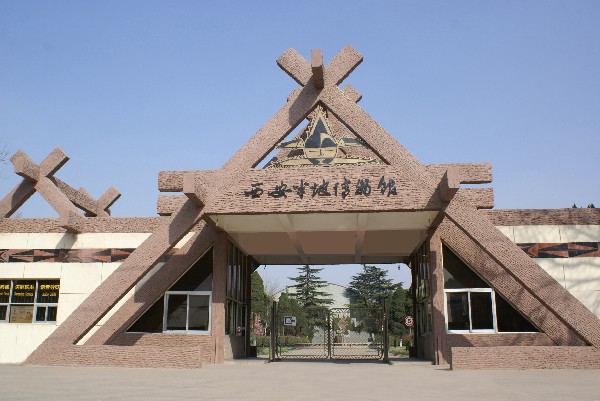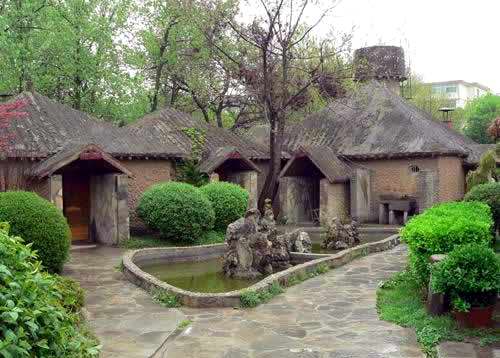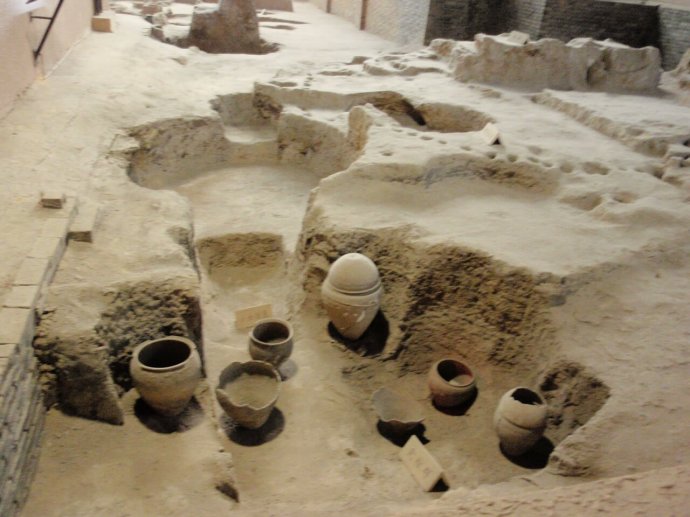Brief Introduction
Located between the Chanhe and Bahe rivers in the eastern city, the Banpo museum houses a 6,000 years Banpo Village. It was an authentic matriarchal clam community of the Yangshao Culture in the Neolithic Age that can be traced back to 5,000 to 3,000 BC. The museum is so named because the village ruins were accidently unearthed near the present-day Banpo village in 1953, when the Banpo Power Plant was under construction.
This is the first on-the-site museum in China on the basis of the archaeological excavation. It wasbuilt in 1958, and now is under the state protection. From 1954 to 1957, five excavations have been done and it is estimated the village covers an area of 50,000 square meters. Now only about 4,000 square meters have been excavated. The exhibition can be divided into three sections: the Residential Section, the Pottery-making Section and the Burial Section.

Background Knowledge
Yangshao Culture
It belongs to China’s Neolithic Age. It was named after Yangshao Village discovered in Henna Province in 1921. Yangshao culture is also known as the Painted Pottery Culture due to its prosperous painted pottery art. The culture was located mainly in the middle and lower reaches of the Yellow River Valley.
Matriarchal Clan Community
It is believed that matriarchal clan community began with the birth of primitive clan communes, and came to an end not long before patriarchal society was established. It was just in the period spanning the late Paleolithic and early Neolithic Age. In a matriarchal society, women played the dominated role. In the early period, women were engaged in gathering while men were occupied with hunting and fishing. Because of the intertribal communal marriage that men were married to women. During the time they lived together, both could have sexual relations with others. As a result, children were closely associated with their mothers. They didn’t know their fathers. Theyfollowed their mothers in the family pedigree. In the later period, the marriage became exogamy. Women took up farming, and managed tribe affairs and economic life. Husband lived in the homes of their spouses, and they were also recorded together with their property in their wives’family pedigree.

The Residential Section
The residential section is the main body of the village. About 46 houses remains, two pigsties, andmore than 200 cellars were discovered here. You can see how the houses were built in the video beside each house ruin.
In the center of the hall, there is a large house which is larger than the other houses. It covers an area of 160 square meters. It is believed that this large house was used as a meeting hall in whichBanpo people discussed their communal affairs and held some religious and ritual activities.
There is a half-underground square room. It has entrance and a threshold to stop rainwater. It also has a pit in the center, which served as fire pit in ancient times. Fire was most important for primitive people’s life. It is indispensable for cooking, heating and lighting. The jar outside of the room was used to keep a child’s corpse. In the primitive society, children death rate was quite high due to the difficult living condition. According to the rule of the Banpo people, dead children could not be buried together with the adults in the communal cemetery. Mothers would put their children’s corpse in the jars and put them beside their houses. This shows the mother’s affection to their children. They thought the children were too young to take care of themselves, so they must put them near the houses. These houses may look primitive today, but they really represent a big step forward from cave dwellings.
The deep holes scattered outside the houses were cellars used to store tools and grain. There are altogether 200 cellars discovered here. Some are small and in irregular shapes while some have large capacity and shape like a pocket with mouth smaller than the bottom. The former ones were the firstly appeared cellars while the later ones were the latterly appeared ones. This shows the growth of productivity and the increase in the output of production. All of these cellars are in open air. It shows the Banpo people worked together, and enjoyed equal distribution. They lived in a primitive society without classes, exploitation or private property.
Outside of all the house remains, you can see a deep ditch clearly. It’s six meters in both depth and width. Its main purpose is to protect Banpo people from attacks of wild beasts and damage from heavy rainfall. Based on estimates, more than 10,000 cubic meters of earth was removed. Suppose that a truck can carry a load of 3.3 cubic meters of earth each time, as many as 3,666 trucks would have been used to transmit the earth. The Banpo people got themselves organized, and together completed this great project only with their rough tools. They cherished a stong desire to overcome difficulties and conquer nature.

The Burial Section
This hall displays the bones of the deceased people discovered here. There are some individual burial pits and some combined burial pits.
The bones had different gestures. Some were buried with their faces upwards, some were buried with their faces downwards, and the ‘second burial’ or the ‘washing bone burial’were also found. When a person died, his corpse would be placed somewhere for a period of time. Then people collected his bones and buried them formally in the cemetery, hence the name of the burial rite.
The heads of the deceased were directed to the west, probably because they believed the deceased would enter another world after death, and that another world existed in the direction of the sunset.
There is a speical jar group for the dead children. Totally 73 jars were found here to hold children’s corpse. It shows the really high children death rate at that time and how hard the Banpo people fight against the nature to live.
The Pottery Kiln Site
There were two kinds of pottery kilns: horizontal and vertical kilns. The vertical kilns were more advanced in the structure. Here on display is a best-kept horizontal kiln. The pottery making art is one of the greatest inventions in the human’s history against the nature. Though the kiln itself was damaged, we can also see its interior structure and the using approach. Due to the relatively small capacity, each kin could only produce three to five small utensils or one to two large utensils. The Banpo people fired wood to heat the pottery, but the temperature in the kiln could reach as high as 800℃ to 1000℃. The pottery utensils would have good hardness and perfect colors only when the temperature was controlled rightly. The large number of complete and beautiful pottery utensils excavated here just verifies the high technique of the Banpo people.

Cultural Relics Exhibited in the Exhibiton Hall
If you have enough time, you can visitor the exhition hall. The first display hall mainly shows the social life, culture and art of the Banpo People and the second display hall mainly shows theeconomic life of the Banpo people. You will see lots of orginal red pottery jars, basins and all kinds of daily utensils and decorations excavated in the Banpo Village.
Banpo is a mysterious place in China. The museum is just like a mirror reflecting some aspects of the ancient Chinese people. There are a lot more for the modern scientists to discover.
Tips
|
Location
|
No. 155, Banpo Road, Eastern Xi’an
|
|
Drive Distance
|
nine kilometers (half an hour drive) away from the center of the city
|
|
Opening Time
|
Dec-Feb: 8:00 to 17:30
|
|
Mar-Nov: 8:00 to 18:00
|
|
Ticket Price
|
Dec-Feb: RMB 45yuan per person
|
|
Mar-Nov: RMB65yuan per person
|
|
Visiting Time
|
one hour
|











